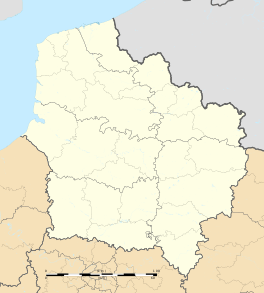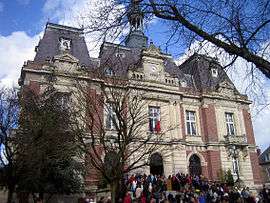Doullens
| Doullens | |
|---|---|
|
Town hall | |
 Doullens | |
|
Location within Hauts-de-France region  Doullens | |
| Coordinates: 50°09′27″N 2°20′29″E / 50.1575°N 2.3414°ECoordinates: 50°09′27″N 2°20′29″E / 50.1575°N 2.3414°E | |
| Country | France |
| Region | Hauts-de-France |
| Department | Somme |
| Arrondissement | Amiens |
| Canton | Doullens |
| Intercommunality | Doullennais |
| Government | |
| • Mayor (2001–2015) | Christian Vlaeminck |
| Area1 | 33.4 km2 (12.9 sq mi) |
| Population (2006)2 | 6,820 |
| • Density | 200/km2 (530/sq mi) |
| Time zone | CET (UTC+1) |
| • Summer (DST) | CEST (UTC+2) |
| INSEE/Postal code | 80253 / 80600 |
| Elevation |
52–152 m (171–499 ft) (avg. 64 m or 210 ft) |
|
1 French Land Register data, which excludes lakes, ponds, glaciers > 1 km² (0.386 sq mi or 247 acres) and river estuaries. 2 Population without double counting: residents of multiple communes (e.g., students and military personnel) only counted once. | |
Doullens is a commune in the Somme department in Hauts-de-France in northern France.
Its inhabitants are called Doullennais and Doullennaises.[1]
Geography
Doullens is situated on the N25 road, in the northern part of the department, straddling the river Authie, the border with the Pas-de-Calais. Doullens is practically mid-way on the intersection of these axes :
- Abbeville - Arras
- Amiens - Saint-Pol-sur-Ternoise
- Crécy-en-Ponthieu - Bapaume
- Auxi-le-Château - Acheux-en-Amiénois
History
- Doullens, the ancient Dulincum, was seat of a viscountship under the counts of Vermandois then of Ponthieu (Hare) and an important stronghold in the Middle Ages.[2]
- In 1225, the town became part of France.
- In 1475 it was burnt by Louis XI for openly siding with the Duke of Burgundy.[2] It received its name Doullens-le-Hardi from its gallant defense in 1523 against the Anglo-Burgundian army.
- In 1595 it was besieged and occupied by the Spaniards, who massacred the entire population. It was restored to France by the Peace of Vervins (1598).[2]
- On 26 March 1918, orders giving General Foch overall command of the allied forces on the western front were signed in a room in the town hall.
Sites and monuments
Sites and monuments include:
- the ruins of Saint-Pierre, partly of the 13th century, used as a barn in the nineteenth century (Hare).
- Notre-Dame church.
- the early 17th century brick belfry.
- the Citadel, built by Vauban, which has often served as a state prison, and later, a reformatory for girls. When Victor Hugo saw the Citadel in August 1837, the famous writer said, "I don't like citadels!"
Town motto
Infinita decus lilia mihi prestant
Photographs
 Church of St-Pierre
Church of St-Pierre Notre-Dame church
Notre-Dame church Belfry and Tourist office
Belfry and Tourist office_2.jpg) Interior of the Citadelle
Interior of the Citadelle Notre-Dame church seen from the Citadelle
Notre-Dame church seen from the Citadelle- Doullens belfry, in the 19th century
 Information placard of the Citadelle
Information placard of the Citadelle_carnaval_085.jpg) Summer Carnival in Doullens (2009)
Summer Carnival in Doullens (2009)
Population
| Year | 1936 | 1946 | 1954 | 1962 | 1968 | 1975 | 1982 | 1990 | 1999 | 2006 |
|---|---|---|---|---|---|---|---|---|---|---|
| Population | 5770 | 5404 | 6169 | 6321 | 7119 | 7495 | 7054 | 6615 | 6279 | 6820 |
| From the year 1962 on: No double counting—residents of multiple communes (e.g. students and military personnel) are counted only once. | ||||||||||
See also
References
- ↑ "Annuaire-Mairie"
- 1 2 3
 One or more of the preceding sentences incorporates text from a publication now in the public domain: Chisholm, Hugh, ed. (1911). "Doullens". Encyclopædia Britannica. 8 (11th ed.). Cambridge University Press. p. 449.
One or more of the preceding sentences incorporates text from a publication now in the public domain: Chisholm, Hugh, ed. (1911). "Doullens". Encyclopædia Britannica. 8 (11th ed.). Cambridge University Press. p. 449.
- INSEE
- Augustus Hare, North-eastern France 1896:76.
External links
| Wikimedia Commons has media related to Doullens. |
- Doullens on the Doullennais site (French)
- Site of Vals d'Authie, Nièvre, and Somme (French)
- Doullens on the Quid site (French)
- Official commune site (French)
- Site of the tourist office (French)
- Photos (French)
This article is issued from Wikipedia - version of the 11/8/2016. The text is available under the Creative Commons Attribution/Share Alike but additional terms may apply for the media files.
